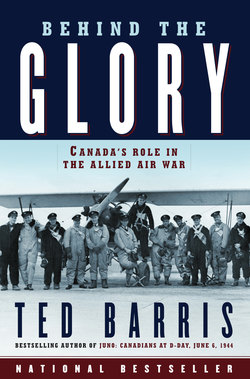Читать книгу Behind the Glory - Ted Barris - Страница 9
На сайте Литреса книга снята с продажи.
ОглавлениеPreface to the Thomas Allen Publishers Edition
From its first appearance in 1992, this book created a stir.
Originally considered a niche subject, Behind the Glory’s story of wartime aviation instructors immediately struck a chord with reviewers and readers. While on a coast-to-coast tour of Canada that fall, I gave 150 interviews in just over two weeks. Reporters seemed drawn to the unsung heroism of the story. Reviewers loved the Hollywood angle. And broadcasters scoured the book’s pages for former instructors willing to go on-air. Even as much of that media went to air or press, copies of the book seemed in short supply. By mid-autumn I was besieged with calls from people desperate to find the book, including from a commercial pilot who flew from Sarnia, Ontario, to Montreal to pick up a reserved copy. Behind the Glory had captured people’s imagination.
Just as important, however, the book kindled long overdue recognition for the nearly forgotten instructors from their air force community. In 1993, for example, many of the 12,000 members of the Allied Air Forces gathered at the Royal York Hotel in Toronto. At its 23rd annual reunion, the association dedicated much of the honours program to those who served in Training Command, in particular, instructors in the British Commonwealth Air Training Plan (BCATP). In a keynote address to AAF members, I highlighted the contribution of Canada’s “unknown soldiers” and reminded the air force veterans present how much they owed their original instructors for their survival. As part of my tribute to the role of instructors, I echoed words of support offered by a former navigational instructor to a graduating class of airmen bound for service in the BCATP in 1942:
“The difference between an operational flyer and an instructor, can be the equivalent to that between a single rifleman and a Bren gunner,” he said. “The operational flyer can fight with only his own brain, his own hands. The instructor can fight with the brains and hands of all the hundreds he influences and teaches.”
That air forces reunion speech proved a watershed. Since its publication, Glory’s research has been the source of many presentations about the BCATP and its neglected instructors. The book became an entrée to similarly address such organizations as the Canadian Aviation Historical Society, the Canadian Warplane Heritage Museum, the Aircrew Association of Canada, the Air Force Association, the Billy Bishop Museum, the Canadian Harvard Aircraft Association, the Royal Canadian Legion, the Canadian Club, the Empire Club, as well as BCATP commemorative societies in Nanton, Alberta, and Yorkton, Saskatchewan. On occasion, the book’s content was presented in support of instructors seeking veterans’ status and pension benefits. During 2005—Canada’s designated Year of the Veteran— History Television aired the documentary “Bomber Boys: A Commonwealth of Heroes” based in part on Behind the Glory content.
Among the hundreds of responses that have inspired the reprinting and publication of this book, was a letter from the son of a former BCATP flying instructor. His correspondence recounted the story of his father’s instant connection to the book. When Glory came his way, the son said, the father apparently immersed himself in its stories cover to cover. He read it again and again, feeling it spoke to him more than other wartime chronicles. Then, when his father’s health faltered, the son said the BCATP veteran eventually became bedridden in hospital. All he requested from home in his last days was his copy of Behind the Glory. It was there in his room when he died.
In the years leading up to its publication and since, the book has yielded hundreds of acquaintances among veterans of the air training plan. At first their stories attracted me. Sometimes their flight logs, diaries, and photo collections did too. But it was their personalities and their passion to keep the BCATP story alive that had me coming back. Several close friendships resulted with, among others, former instructors Charley Fox, Charlie Konvalinka, John Campsie, Joel Aldred, Ted Arnold, Russ Bannock, Henry Gordon, Jack Harris, Norm Harrison, Bob Hesketh, Eric Johnston, Margaret Littlewood, Fred Lundell, John Neal, Don Rogers, Dick Ross, Al Stirton, Ross Truemner, John Trull, and Babe Woollett. Some of these friends are gone now. Gone . . . but still giving my work impetus.
I’m sure that reader response to two other Second World War volumes—Juno: Canadians at D-Day, June 6, 1944 and Days of Victory: Canadians Remember, 1939-1945—released by Thomas Allen Publishers in 2004 and 2005 respectively has helped us reach a decision to reprint Behind the Glory. For that momentum I sincerely thank the editorial, production, marketing and sales teams at Thomas Allen. Nevertheless, I believe it’s the clarity of those original instructors’ recollections and the honesty of their reflections on the unique plan they built that have convinced us a new edition was viable.
Though the British Commonwealth Air Training Plan officially came to an end sixty years ago, its legacy served Canadian aviation long after. Similarly, as the inscription on the BCATP memorial gates at Trenton, Ontario, suggests—“Their shoulders held the sky suspended/They stood, and earth’s foundations stay”—the legacy of the plan’s instructors gives this book renewed life.
Ted Barris
Uxbridge, 2005
